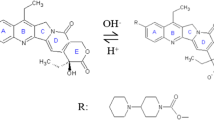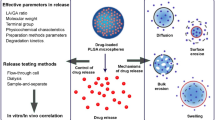Abstract
Purpose. The present studies evaluated the ability of injectable, biodegradable microspheres releasing carboplatin, doxorubicin, or 5-fluorouracil to suppress the growth of solid tumors implanted subcutaneously or intramuscularly.
Methods. Seven to 10 days after implantation of MATB-III cells, rats received systemic chemotherapy, intratumoral bolus chemotherapy, or injections of chemotherapeutic microspheres into the tumor center or multiple sites along the outer perimeter of the tumor.
Results. A single treatment with carboplatin, doxorubicin, or 5-fluorouracil microspheres along the perimeter of the tumors produced a significant, dose-related suppression in tumor growth, relative to injections directly into the tumor center. Moreover, five temporally-spaced microsphere treatments along the tumor perimeter (with either doxorubicin or 5-fluorouracil microspheres) completely eradicated 100% of the subcutaneous tumors and 40-53% of the intramuscular tumors. Polypharmacy, accomplished by blending doxorubicin- and 5-fluorouracil-loaded microspheres and injecting them into the tumors was even more efficacious than sustained delivery of either drug alone. Comparable doses of systemic chemotherapy or intratumoral bolus chemotherapy were ineffective.
Conclusions. Injectable microspheres might be ideal for local, sustained delivery of chemotherapeutic agents to solid tumors. However, attention must be paid to the placement of the microspheres, for injections around the tumor perimeter may be required for efficacy.
Similar content being viewed by others
REFERENCES
R. Jain. Transport of molecules across tumor vasculature. Cancer Met. Rev. 6:559–593 (1987).
R. Jain. Delivery of novel therapeutic agents in tumors: Physiological barriers and strategies. J. Natl. Cancer Inst. 81:570–576 (1989).
R. Jain. Vascular and interstitial barriers to delivery of therapeutic agents in tumors. Cancer Met. Rev. 9:253–266 (1990).
R. Jain. Haemodynamic and transport barriers to the treatment of solid tumors. Int. J. Radiat. Biol. 60:85–100 (1991).
J. Bier, P. Benders, and M. Wenzel. Kinetics of 57Co-bleomycin in mice after intravenous, subcutaneous, and intratumoral injection. Cancer 44:194–2000 (1979).
K. G. Buahin and H. Brem. Interstitial chemotherapy of experimental brain tumors: Comparison of intratumoral injection vs. polymeric controlled release. J. Neuro-oncol. 26:103–110 (1995).
H. Takahashi, K. Nazazawa, and T. Shimura. Evaluation of postoperative intratumoral injection of bleomucin for craniopharyngioma in children. J. Neurosurg. 62:120–127 (1985).
W. D. Ensminger. Regional chemotherapy. Semin. Oncol. 20:3–11 (1993).
H. Brincker. Direct intratumoral chemotherapy. Crit. Rev. Oncol. Hematol. 2:91–98 (1993).
M. Boisdron-Celle, P. Menei, and J. P. Benoit. Preparation and characterization of 5-Fluorouracil-loaded microparticles as biodegradable anticancer drug carriers. J. Pharm. Pharmacol. 47: 108–114 (1995).
D. F. Emerich, M. A. Tracy, K. L. Ward, M. Figueredo, R. Qian, C. Henschell, and R. T. Bartus. Biocompatibility of Poly (DL-Lactide-co-Glycolide) microspheres implanted into the brain. Cell Transpl. 8:47–58 (1999).
D. F. Emerich, S. R. Winn, Y. Hu, J. Marsh, P. Snodgrass, D. Lafreniere, T. Wiens, B. P. Hasler, and R. T. Bartus. Injectable chemotherapeutic microspheres and glioma I: Enhanced survival following implantation into the cavity wall of debulked tumors. Pharm. Res. 17:767–775 (2000).
D. F. Emerich, S. R. Winn, P. Snodgrass, D. Lafreniere, M. Agostino, T. Wiens, H. Xiong, and R. T. Bartus. Injectable chemotherapeutic microspheres and glioma II: Enhanced survival following implantation into deep inoperable glioma. Pharm. Res. 17:776–781 (2000).
C. Fournier, B. Hecquet, P. Bouffard, M. Vert, A. Caty, V. Marie-Odile, L. Vaseymortier, S. Merle, A. Krikorian, J.-L. Lefebvre, A. Delobelle, and L. Adenis. Experimental studies and preliminary clinical trial of vinorelbine-loaded polymeric bioresorbable implants for the local treatment of solid tumors. Cancer Res. 51:5384–5391 (1991).
O. Ike, Y. Shimizu, R. Wada, S.-H. Hyon, and Y. Ikada. Controlled cisplatin delivery system using poly(DL-lactic acid). Biomaterials 13:230–234 (1992).
K. O. Lillehei, Q. Kong, S. J. Withrow, and B. Kleinschmidt-DeMasters. Efficacy of intralesionally administered cisplatin-impregnated biodegradable polymer for the treatment of 9L gliosarcoma in the rat. Neurosurgery 39:1191–1197 (1996).
P. Menei, M. Boisdron-Cellee, A. Croue, G. Guy, and J. P. Benoit. Effect of stereotactic implantation of biodegradable 5-Fluorouracil-loaded microspheres in healthy and C6 glioma-bearing rats. Neurosurgery 39:117–123 (1996).
P. Menei, M. C. Venier, E. Gamelin, J. P. Saint-Andre, G. Hayek, E. Jadaud, D. Fournier, P. Mercer, G. Guy, and J. P. Benoit. Local and sustained delivery of 5-Fluorouracil from biodegradable microspheres for the radiosensitization of glioblastoma. Cancer 86:325–330 (1999).
D. F. Emerich, P. Snodgrass, R. L. Dean, D. Lafreniere, M. Agostino, T. Wiens, H. Xiong, B. Hasler, J. Marsh, M. Pink, B. S. Kim, and R. T. Bartus. Bradykinin modulation of tumor vasculature: I. Activation of B2 receptors increases delivery of chemotherapeutic agents into solid peripheral tumors, enhancing their efficacy. J. Pharmacol. Exp. Ther. 296:628–636 (2001).
D. F. Emerich, R. L. Dean, P. Snodgrass, D. Lafreniere, M. Agostino, T. Wiens, H. Xiong, B. Hasler, J. Marsh, M. Pink, B. S. Kim, B. Perdomo, and R. T. Bartus. Bradykinin modulation of tumor vasculature: II. Activation of nitric oxide and phospholipase A2/prostaglandin signaling pathways synergistically modifies vascular physiologu and morphology to enhance delivery of chemotherapeutic agents to tumors. J. Pharmacol. Exp. Ther. 296:632–641 (2001).
J. Hanes, A. Sills, Z. Zhao, K. W. Suh, B. Tyler, F. DiMeco, D. J. Brat, M. A. Choti, K. W. Leong, D. M. Pardoll, and H. Brem. Controlled local delivery of interleukin-2 by biodegradable polymers protects animals from experimental brain tumors and liver tumors. Pharm. Res 18:899–906 (2001).
R. D. Renn, J. D. Kroin, and J. E. Harris. Chronic intratumoral chemotherapy of a rat tumor with cisplatin and fluorouracil. Appl. Neurophysiol. 46:240–244 (1983).
V. Slavikova, K. Motydka, and K. Slavik. Distribution and pharmacokinetics of methotrexate in localized chemotherapy of solid Gardner's lymphosarcoma. Neoplasma 25:211–216 (1978).
F. H. Hochberg and A. Pruitt. Assumptions in the radiotherapy of glioblastoma. Neurology 30:907–911 (1980).
J. Warneke, N. J. Petrelli, and L. Herrera. Local recurrance after sphincter-saving resection for rectal adenocarcinoma. Am. J. Surg. 158:3–11 (1989).
R. Whittington, M. P. Bryer, D. G. Haller, L. J. Solin, and E. F. Rosato. Adjuvant therapy of resected adenocarcinoma of the pancreas. Int. J. Radiat. Oncol. Biol. Phys. 21:1137–1144 (1991).
E. K. Fishman. Imaging techniques in cancer management: Computed tomography. In V.T. Devita, S. Hellman, and S.A. Rosenberg (eds.), Cancer: Principles and Practice of Oncology, Lippincott-Raven, Philadelphia, Pennsylvania 1997 pp. 643–654.
L. H. Schwartz and R. A. Castellino. Imaging techniques in cancer management: Magnetic Resonance Imaging. In V.T. Devita, S. Hellman, and S.A. Rosenberg (eds.), Cancer: Principles and Practice of Oncology, Lippincott-Raven, Philadelphia, Pennsylvania 1997 pp. 654–663.
S. E. Salmon and A. C. Sartorelli. Cancer Chemotherapy: Drug classification and mechanism of action. In B.G. Katzung, (ed.), Basic and Clinical Pharmacology McGraw-Hill, New York, 1998 pp. 881–911.
D. S. Fischer, M. T. Knobf, and H. J. Durivage. The Cancer Chemotherapy Handbook. Mosby, St. Louis, 1997.
Author information
Authors and Affiliations
Corresponding author
Rights and permissions
About this article
Cite this article
Emerich, D.F., Snodgrass, P., Lafreniere, D. et al. Sustained Release Chemotherapeutic Microspheres Provide Superior Efficacy over Systemic Therapy and Local Bolus Infusions. Pharm Res 19, 1052–1060 (2002). https://doi.org/10.1023/A:1016434926649
Issue Date:
DOI: https://doi.org/10.1023/A:1016434926649




